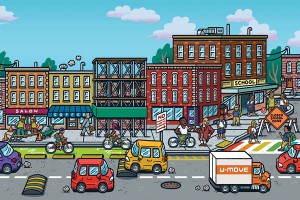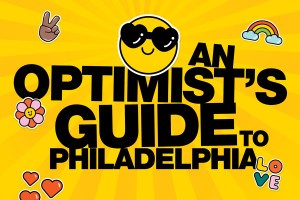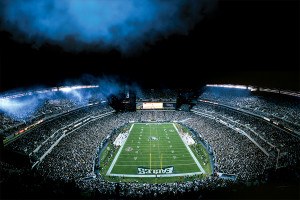Frazier vs. Rocky: Philly Got Its Hero Wrong
Bill Burr was doing a stand-up comedy bit for the Opie and Anthony Traveling Virus Show in Camden in 2006, and the crowd had turned ugly. He decided to turn from his prepared comedy routine and start ripping the crowd of young Philadelphians. He ripped the Flyers, Ben Franklin, the Liberty Bell, everything the New England-born Burr could think of. And then he went for the jugular.
“Bunch of fucking losers,” he shouted at a booing crowd. “Fucking Rocky is your hero. The whole pride of your city is built around a fucking guy who doesn’t even exist. You got Joe Frazier from here but he’s black so you can’t fucking deal with him, so you make a fucking statue of some three-foot fucking Italian you stupid Philly cheese-eating fucking jackasses.”
Mike Todd is the director and producer of When the Smoke Clears, a documentary about Frazier that recently premiered to a sold-out crowd in New York. He says about the Rocky phenomenon in Philly, “The bitter irony of it is that the Art Museum steps were part of Joe’s running route. He’d run through Fairmount Park and up the steps. That the fictional character has (a statue) there and is the one remembered for it is slightly strange.”
“Honestly, it’s not just Philly,” says Joey “Eye” Intrieri, legendary Philadelphia cut man and former boxer. “Everybody loves the fantasy-world bullshit. Look at the movies with the mobsters and the gangsters and the cops. Shaft gets respect but a typical cop walking down the street nobody pays attention to.”
Joe Frazier was a lot of things, not all of them positive. He was arrested in 2004 for simple assault, though charges were later dropped. He admitted that some of his financial problems later in life had partly to do with his penchant for gambling and partying. But he was most certainly not a fan of “fantasy-world bullshit.”
“He was a real Philly guy,” says Joey Eye (who doesn’t have a problem with the Rocky statue, but thinks that Frazier should have had one as well). “He’d give you the shirt off his back. He didn’t mix words. Wasn’t flashy. You coulda met Joe any day of the week and shake his hand. He would never turn anybody away.”
Joe Frazier may not have been born here, but there have been few athletes pass through this city who were more “Philly guy” than Joe Frazier. He aces every measure Philly claims to judge their athletes on.
Champion. In a city starved for champions, Joe was one. He won the heavyweight title with a devastating TKO over Jimmy Ellis in 1970, then defended it against an undefeated Muhammad Ali in the Fight of the Century at Madison Square Garden in 1971.
Self-made man. He was born to dirt farmers in South Carolina. He moved north at age 15, with no one to depend on but himself. He went to work in a meatpacking shed in Philly at age 16, staying in shape by pounding sides of raw meat (sound familiar?). According to Eye, who was the cut man for Joe’s son Marvin and daughter Jackie Frazier-Lyde, “Joe always said, ‘Ain’t nobody gonna give me anything. You gotta go out and work hard for it and get it yourself.’”
Toughness. In the 1964 Olympics, the southpaw Frazier broke his left thumb in the semifinals. He won the match, then won gold while fighting with a broken thumb. He became heavyweight champion despite being legally blind in one eye, a handicap he never revealed until his career was long over. In his third fight with Ali, the other eye was swollen entirely shut in the late rounds. And yet, despite the fact that he couldn’t see anything, he begged his trainer to let the fight continue.
Gave back to the city. Though he spent his final years in relative poverty, Joe was at one time a very wealthy man. But for most of his adult life, he ran a small boxing gym on North Broad Street that catered to the poor, and lived in a humble apartment above it. And when his finances did falter, he didn’t just cut ties with the gym and try to save himself. He tried desperately to hold onto that gym.
Didn’t showboat, but didn’t take shit from anybody, either. In the first of their three epic battles in the ring, Muhammad Ali was dominating Frazier early. He taunted Frazier, asking him, “Joe, don’t you know I’m God?” Frazier replied, “Lord, you’re in the wrong place tonight.” Frazier won a 15-round decision.
So why is Rocky the boxing hero of Philadelphia, and Joe Frazier, who embodies all we claim to love in our athletes, seemingly a footnote? Is it, as Burr accused, because of racism? It is undeniable that white America has long hungered for a Great White Hope in boxing, and it is not exceedingly cynical to suggest that when they couldn’t produce one, they created one in Hollywood. But racism hardly explains it all. We’re a city that has more African-American citizens than white ones. Furthermore, other black athletes of Frazier’s era are still adored in this city by blacks and whites alike. Dr. J is an icon here, and Mike Quick and Garry Maddox are both beloved by nearly all Philadelphians.
Part of it surely has to do with the decline of boxing. It is a very different world than the one that Ali and Frazier fought in 40 years ago. Boxing was king then. Now it is tucked somewhere between MMA and indoor lacrosse in terms of popularity. Men like Don King have driven the sport into the ground while enriching themselves, so most people simply don’t give it much thought.
“I also think it’s because Joe wasn’t a PR man,” says Todd. “He was who he was and he was prone to speak his mind.”
But if that’s the case, then why does this city adore former Eagles coach Buddy Ryan, who spoke his mind and never won squat?
Is it because we love the “fantasy world,” as Joey Eye says? Yes and no. There is little doubt that we love a good Hollywood story (which Rocky undoubtedly was—the first one anyway), but athletes are almost as much a part of “fantasy world” as Hollywood is. If there are any American heroes who shine as bright as movie stars, they are pro athletes. We loved Dr. J because of what he did on the court, not because of his acting in The Fish Who Saved Pittsburgh.
I spoke with Johnny Carter, a Philly boxer who came up in the 1970s, and who currently runs the boxing gym at the Marian Anderson Rec Center. While he said that Joe was “well respected” among the boxing community, he didn’t think he had gotten the respect he deserved from the city he called home. “No,” said the former bantamweight, who used to train occasionally at Joe’s Gym as a teenager. “I don’t think he got his just due.” When asked why he thought Rocky was bigger than Joe, the 54-year-old trainer paused, clasped his hands together, and said, “That’s a good question. I’ve thought about it, and … ” He nodded his head. “I just don’t know.” Sometimes there simply are no answers.
In 2006, a debate raged in the city about what to do with the Rocky statue. Should it stay at the stadiums or move to the Art Museum? As the controversy swirled, the sixth Rocky film was released. Rocky Balboa was a huge hit, making $155 million at the box office.
As the statue controversy raged on the front pages of Philadelphia newspapers and people poured into theaters to exult in a fictional character who ran up the Art Museum steps and punched sides of beef, Joe Frazier was quietly fighting what would be his last major fight. He was desperately trying to keep open his tiny gym in one of the poorest parts of the city. He could not. It went bankrupt and closed in 2008.
Says the British film director Todd, whose film documents Frazier’s vain attempts to keep the gym open, “When the boxing identity of a city becomes so connected with a fictional character, while one of the sport’s true global icons struggles to survive and keep a gym going in one of the poorest parts of the city … well, it’s just a sad story.”
Bill Burr’s rant at the Tweeter Center ran for 10 minutes and went viral on You Tube. At the end of his epic tirade, he decided to make one last point. As the crowd, at this point whipped into a frenzy, screamed wildly, the fuming Burr asked again, ”Why don’t you fucking build something for Joe Frazier?” and then stormed off stage.
Joe Frazier died on Monday night, knowing that nothing had been built for him in the city that he called home. Instead there was a furniture store where his gym had stood, and there was a statue of a fictional character at the city’s Art Museum. A statue of the pride of our city. A statue of a guy who doesn’t even exist in a city that prides itself on being real.


